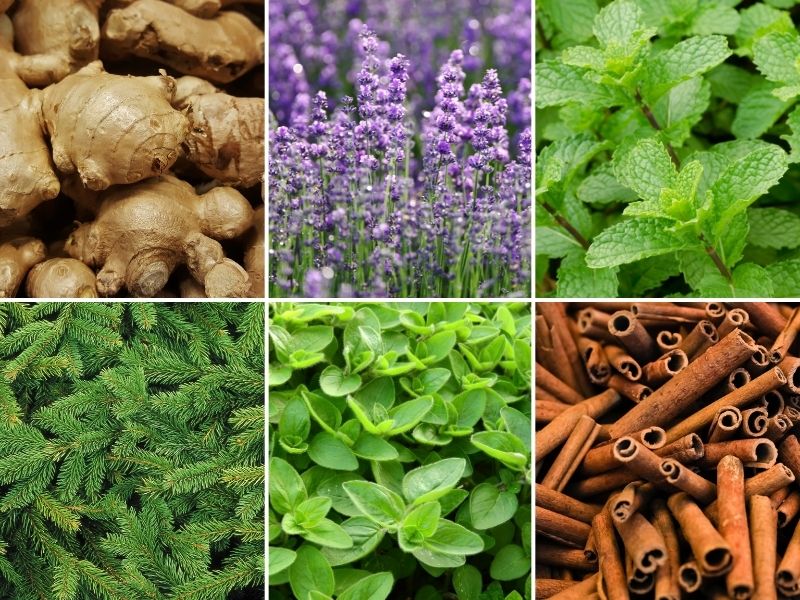Updated in March of 2025 by Ilana Rose Frigaard, ACHS Chief Operating Office, and reviewed by Dr. Judith Thompson, ACHS Dean of Herbal Medicine.
Minor aches and pains can be an everyday annoyance, whether from exercise, long hours at a desk, or simply the wear and tear of daily life. Fortunately, nature offers a variety of herbal remedies that can be easily used at home to support the body’s natural healing process. From soothing teas and balms to massage blends, these simple DIY solutions can help ease sore muscles and stiffness without the need for complicated ingredients. Let’s explore six powerful herbs that you can incorporate into your daily routine for natural, at-home relief.
1. Ginger
Historically, Zingiber officinale (Roscoe), commonly known as ginger, has been used for centuries in traditional medicine across China, Japan, and India. The primary parts used are the underground root and rhizome, which can be prepared as a tea, ground into a powder, extracted into a supplement, encapsulated, or used as an essential oil. There is some scientific evidence that ginger Z. officinale can relieve inflammation and thereby contribute to pain relief.1
Dr. Krishna C. Srivastava, a researcher specializing in the medicinal properties of spices at Odense University in Denmark, has studied ginger’s effectiveness as a mild pain reliever. In a study where arthritis patients consumed small daily doses of Z. officinale for three months, most participants experienced notable improvements in pain, swelling, and morning stiffness.2
Some individuals combine Zingiber officinale with Cinnamomum zeylanicum (Blume), commonly known as cinnamon, for its soothing properties. Many people find that drinking ginger tea provides warmth and comfort, helping to alleviate minor aches and pains while also offering a sense of well-being, especially on cold winter days.
2. Lavender
Lavandula angustifolia (Mill.), commonly known as lavender, is widely recognized for its calming properties, often used to promote relaxation and sleep. However, research and traditional use also suggest its potential to soothe minor pain. Historically, lavender has been applied externally to alleviate burns and minor aches and pains. A study found that application of diluted lavender essential oil to minor burns promoted faster healing.3
Lavender Blend for Burns:
- 15 drops Lavender Oil Lavandula angustifolia (Mill.)
- 6 drops Immortelle Oil Helichrysum italicum (Roth)
- ½ Ounce St. John’s Wort Hypericum perforatum (L.)
- ½ Ounce Aloe Vera gel
Directions: Blend all ingredients and store them in the refrigerator. This formula can also be used on sunburns.
Studies have also explored lavender’s role in pain management. In one study, inhaling lavender essential oil was a potentially safe and effective method for alleviating persistent headaches, with a statistically significant number of participants reporting positive results.4
Additionally, research indicates that lavender may assist in post-surgical pain relief. In a study involving women who underwent breast biopsy surgery, those exposed to lavender experienced better pain control compared to the control group.5 Beyond these applications, Lavender essential oil diluted appropriately is commonly added to baths to help soothe muscle and joint discomfort, offering a natural approach to minor pain relief.
3. Peppermint
Peppermint Mentha ×piperita L. is often associated with candy canes and after-dinner mints, but it has long been used for more than just flavor. Many people turn to peppermint for its ability to relax muscles and provide soothing relief.
Traditionally, peppermint essential oil has been used to ease muscle tension, including menstrual cramps, as it appears to help muscles relax. It may also offer support for nerve discomfort—diluted peppermint essential oil applied to the skin has been reported to help calm the nervous system during times of stress.6
For those looking to relieve tension, applying diluted peppermint essential oil to the temples and forehead is a common practice. A small study even suggests that this method may effectively ease tension-related discomfort.7
4. Pine
The scent of pine is often associated with fresh evergreens and is commonly described as invigorating and refreshing. Beyond its aromatic appeal, pine bark extract has shown potential benefits in supporting joint health.
Research suggests that pine bark extract may help alleviate inflammation associated with osteoarthritis. In a recent study, patients who were treated with pycnogenol, a pine bark extract derived from French maritime pine, experienced significant improvements in mild to moderate osteoarthritis symptoms.8
5. Marjoram
Marjoram Origanum majorana (L.) is commonly used as a culinary herb. However, there is some evidence that it can help to relieve minor aches and pains. Marjoram essential oil can help support healthy joint, muscle, and cartilage function.9 It can also support a healthy digestive and nervous system. A tea made from the leaves or flowers can be used to maintain nose, throat, and ear health.10
In scientific studies, marjoram essential oil has shown analgesic properties. There is a constituent in the oil that interferes with prostaglandin production and causes cramps associated with the menstrual cycle. There is also a component of marjoram that has an anesthetic value.11
Muscle Ache Massage Blend
- 6 drops Marjoram Oil Origanum majorana
- 12 drops Black Pepper Oil Piper nigrum
- 6 drops Ginger Oil Zingiber officinale
- 6 drops Juniper Berry Oil Juniperus communis
- 2 ounces Sweet Almond Oil Prunus amygdalus var. dulcis
6. Cinnamon
Cinnamon Cinnamomum zeylanicum is often associated with holiday treats, spiced beverages, and warming flavors. Beyond its culinary appeal, cinnamon has been traditionally used for its potential benefits in supporting joint and muscle comfort.
One common remedy involves making tea with one teaspoon of C. zeylanicum and two teaspoons of honey, which is believed to help promote joint and muscle ease.12 Additionally, powdered C. zeylanicum bark mixed with water has been historically used to help with headaches.13
Whether inhaled as essential oils, brewed into teas, or prepared as tinctures, these botanical solutions offer a gentle, holistic approach to relief. While herbal remedies can be a valuable addition to self-care, it is always important to use them mindfully and consult with a healthcare professional when needed. By embracing the power of nature, individuals can take small yet meaningful steps toward greater comfort and wellness in everyday life.
This article is for informational purposes only. It is not intended to treat, diagnose, cure, or prevent disease. This article has not been reviewed by the FDA. Always consult with your primary care physician or naturopathic doctor before making any significant changes to your health and wellness routine.
Sources:
- Terry, R., Posadzki, P., Watson, L. and Ernst, E. (2011). The Use of Ginger (Zingiber officinale) for the Treatment of Pain: A Systematic Review of Clinical Trials. Pain Medicine, 12(12), pp.1808-1818.
- Srivastava, K. and Mustafa, T. (1989). Ginger (Zingiber officinale) and rheumatic disorders. Medical Hypotheses, 29(1), pp.25-28.
- Mori, H. M., Kawanami, H., Kawahata, H., & Aoki, M. (2016). Wound healing potential of lavender oil by acceleration of granulation and wound contraction through induction of TGF-β in a rat model. BMC complementary and alternative medicine, 16, 144. https://doi.org/10.1186/s12906-016-1128-7
- Sasannejad, P., Saeedi, M., Shoeibi, A., Gorji, A., Abbasi, M. and Foroughipour, M. (2012). Lavender Essential Oil in the Treatment of Migraine Headache: A Placebo-Controlled Clinical Trial. Eur Neurol, 67(5), pp. 288-291.
- Kim, J., Wajda, M., Cuff, G., Serota, D., Schlame, M., Axelrod, D., Guth, A. and Bekker, A. (2006). Evaluation of Aromatherapy in Treating Postoperative Pain: Pilot Study. Pain Practice, 6(4), pp.273-277.
- National Center for Complementary and Integrative Health (2020, Oct). Peppermint Oil. U.S. Department of Health and Human Services. Retrieved April 2, 2025, from https://www.nccih.nih.gov/health/peppermint-oil
- Göbel, H., Schmidt, G., Dorschak, M., Stolze, H. and Heuss, D. (1995). Essential plant oils and headache mechanisms. Phytomedicine, 2(2), pp.93-102.
- Cisár, P., Jány, R., Waczulíková, I., Sumegová, K., Muchová, J., Vojtaššák, J., Ďuraćková, Z., Lisý, M. and Rohdewald, P. (2008). Effect of pine bark extract (Pycnogenol®) on symptoms of knee osteoarthritis. Phytotherapy Research, 22(8), pp.1087-1092.
- Lis-Balchin, M., Hart, S., Deans, S. and Eaglesham, E. (1996). Comparison of the Pharmacological and Antimicrobial Action of Commercial Plant Essential Oils. Journal of Herbs, Spices & Medicinal Plants, 4(2), pp.69-86.
- Webmd.com, (2024). Marjoram: Uses, Side Effects, Interactions and Warnings. Retrieved April 2, 2025, from https://www.webmd.com/vitamins/ai/ingredientmono-563/marjoram
- Ou, M., Hsu, T., Lai, A., Lin, Y. and Lin, C. (2012). Pain relief assessment by aromatic essential oil massage on outpatients with primary dysmenorrhea: A randomized, double-blind clinical trial. Journal of Obstetrics and Gynaecology Research, 38(5), pp.817-822.
- Graedon, T. (2011). Cinnamon and Honey Relieve Joint Pain. Home Remedies. http://www.peoplespharmacy.com/2011/06/20/cinnamon-and-honey-relieve-joint-pain/
- Aggarwal, B. and Kunnumakkara, A. (2009). Molecular Targets and Therapeutic Uses of Spices. World Scientific Publishing.



